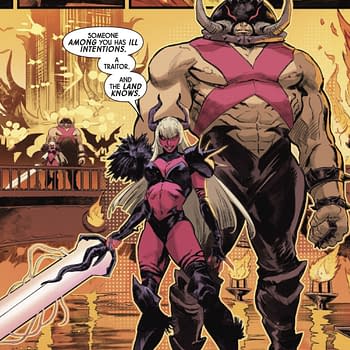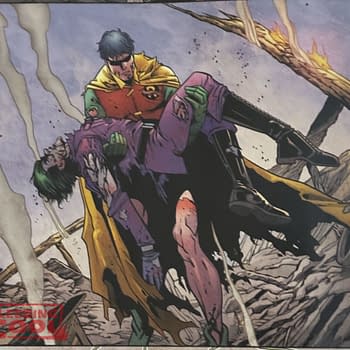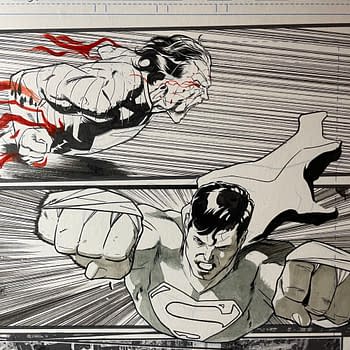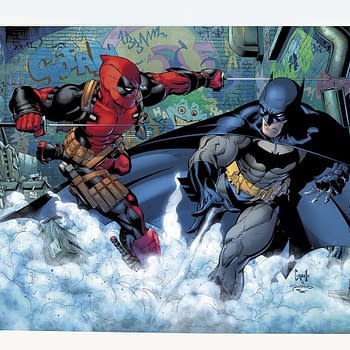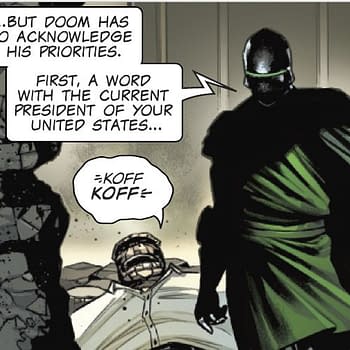Posted in: Comics, Recent Updates | Tagged: chris ryall, Eric Shanower, gabriel rodriguez, idw, jay fotos, joe hill, little nemo in slumberland, Locke & Key, Robbie Robbins, wondercon
Unlocking The Lockes And Finding Little Nemo – Gabriel Rodriguez In The Bleeding Cool Interview At Wondercon

I was delighted to talk to Gabriel Rodriguez at Wondercon about his visual creation of the Locke & Key characters, how he views the series now, and why Little Nemo is the "perfect" book for him right now. In fact, the very next day at Wondercon, IDW announced that Rodriguez was the first artist to be signed for an exclusive contract by the company. In many ways, Rodriguez, and his work, is the future of IDW and Little Nemo could be just the beginning of that development.
HMS: I'll start off with a really general question for you as an artist. How do you go about designing a character when you know you have never drawn them before. What's your first step? What's your process on that?
Gabriel Rodriguez: I've had different processes on different projects. I started making comics that were adaptations of TV series or movies, so then I had direct reference of how I needed to interpret that character. But then when we did, for example, the adaptation of [Clive Barker's] The Great and Secret Show by Chris Ryall, then we had a lot of discussions, and we took several references from different people who exist in the real world and adapted them to create the characters.
But in the case of Locke & Key, for example, it was completely different. Because all I got to start working on the design of the characters was brief notes from Joe in which he had a 3-line description of each one of those characters and then he told me "Ok. Let's see what you can do with this". And the characters just popped out of my mind. Aside from some little details like changing hairstyles here and there, it was almost pretty much like what they became in the comic. And I think it was sort of a magical experience for me because I had never done it like that before. And I only had reference for one character. That was Bode Locke, because I took my own kid as a reference for him. Because when I was starting Locke & Key, he was about 5, 6 years old, and Bode was supposed to be just a little older. But many of his features, and the body language for the character came from my son. But all the others just came out of my mind, and I think it was only in 2 or 3 days that I designed all the main characters for the series.
HMS: That's interesting what you're saying about Bodie, because his movements, and his little gestures are what make him so believable, so real, to me.
GR: Yeah. For me, I remember when I was reading the first scripts, Joe [Hill] had such a talent to create a special voice for each of the characters and especially with the kids. Because Tyler, Kinsey, and Bode were really well fleshed out, so that you could even see the age difference between them just by reading the text. So I tried to be as close to that with the drawings themselves, tried to give them a very unique body language for each one. And also trying to get some details for each one of them so that you could realize they were brothers and sisters, and also having them relate to their parents, too. To have this family appeal in the characters who were blood-related in the story. All of those were details that we started discussing with Joe early on when we started discussing the first series, Welcome to Lovecraft.
HMS: There's a whole complexity there that I hadn't even thought of, of trying to draw a whole family and show how they relate to each other. Was that the first time you had worked so much with teenagers and with kids in your drawings?
GR: Yes. Yes, it was the very first time we had this sort of young casting in contrast with the world of adults. And I was trying to be very careful and distinguish properly the two stages. Because I knew that one of the most important topics of the story was going to be how it is to be a teenager and become an adult. So, at the beginning, in which I was pretty sure of my skills as a storyteller but wasn't as sure in my skills as a drawing artist, I tried to develop a style that was very exaggerated at first, with very wide eyes and expressive mouths, and stuff like that. Because I wanted to be very accurate in order to display the emotions of the characters and also knowing my limits and my ideas.
And luckily, it happened in the development of the story, that I could try a more subtle approach to the design of the characters as the series kept developing. So, in a way, you could see in the drawing themselves, that the characters keep growing and maturing as the series develops. So you get, especially in the case of Tyler Locke, if you look at Tyler at the beginning of the series, and what he became at the ending, I tried to make the design process of the character be an equal part of the piece. With psychological, moral, and personal development alongside the story. So I felt I was pretty lucky to have the chance to develop that kind of stuff also as part of the content of the story.
HMS: Is that particularly useful when a series stretches over a long period of time? That you have that opportunity for developing things more?
GR: Yeah. I think one of the key elements for the success of Locke & Key and for allowing it to become what it became was the way in which IDW allowed us to develop the story. The idea of separating the books as if they were seasons of a TV show, building the comics so that we were allowed to have a pause in between the books so Joe and I could have room to discuss ideas and give them a twist sometimes. Or reflecting about which part of the story we wanted to tell immediately and which ones we were going to save for later. That I think you can see in the books. And we tried to give each one of them a special voice and a special reason to be in the overall story. So, I'm very grateful that IDW gave use room and patience for us to have that kind of reflection on the stuff we were doing. I think it was very important for the story to mature properly along with its development.
We were, in fact, able to do exactly what we wanted to do with each and every element of the story, the design of everything. So if there any problems with the design of the book, it's completely on us because we had all the freedom we wanted, we had all the support we wanted, and that kind of relationship with the publisher was an integral part of what the project became. So, I'm very grateful and this is truly the result of a team effort.
I think everyone who collaborated on this book, from Joe's writing and my work to Jay Fotos' amazing color work that gave such a special voice to the books themselves, and Robbie [Robbins'] work, not just on the lettering, but in the design of the books to give them a special look and a special appeal for the readers, and of course Chris [Ryall] editing and supervising all the stuff and guiding us throughout the journey was an amazing experience. For me, it's very important to be aware that the success of this series was mostly because everyone involved gave their very best on their books and everyone else was so grateful to have such teammates to develop the story. And I'm especially very thankful for having the chance to do the complete run of Locke & Key with the same team, especially with Jay Fotos. I'm so grateful for all that he has done for each and every one of the projects that we have shared. Because including Locke & Key, I think I've shared about 8 or 9 years in a row working with Jay and the guy sometimes surprises me with his choices, but I think each and every one of them was pretty accurate in what the project needed at that particular moment. So I'm very grateful.
HMS: The whole emotional tone of that book, I think, is in the colors.
GR: One of the things that is a marvel to me is that throughout the story, you can almost feel the moisture in the air around the characters. It's not just how it looks, but how it feels. In a way, he reflects both the environment that surrounds the characters, and also the psychological drama that's going on in the story. Just in the color work. Being so realistic but magical at the same time. It's such a unique quality in his work.
HMS: I agree. When I read it, I feel like I'm covered in paint afterwards, right? It's on me.
GR: Yes, exactly.
HMS: Well, an obvious question, then. You seem very upbeat to have come to the conclusion successfully of Locke & Key. Because it's been such a long project and you wanted everything to be right?
GR: Yes. We were very happy because just about the ending of Locke & Key, we started discussing almost everything that happened in the last book with Joe three years ago. Because when we were working on Head Games, the second book, we started thinking about what we wanted to do in the upcoming volumes, how long the series was going to be. At the beginning, we had the idea to develop the whole story in 48 issues, but then we realized we didn't need that much room. That it would be better to concentrate some stuff, to avoid repetition or getting too procedural because that wasn't the nature of the story.
So, in that regard, developing the fourth book, Keys to the Kingdom, was very important. Because we put a lot of ideas in there that I think if we had developed any of the ideas in there into single books, I think it would have been, "Ok, it's the key of the week and how to beat the monster", and it would have been repetitive. So instead of that we decided to condense all of that into just one book and then with that, close the second arc of the story and then make room for the final arc. Which was the explanation of the origin of the mythos in the whole fifth book, then the final run-down in the sixth one. For us, that was very cool to have the chance to have everything explained up until the fifth book so that we just had plenty of room for a proper ending in the sixth one. And to give proper space to each one of the characters, and for the conflicts of the story to each have their own ending in a proper way. And not to cram too much stuff into the last couple issues.

GR: Yes. For me it was almost six years of seven days a week, ten hours a day working on this. So it was very important for us to finish it properly. Also both Joe and myself were both traumatized by what happened to the X-Files. We were both hard core fans and we loved the series until the fifth season. But after that it all crumbled apart and just from overstretching it. So we were so focused on the idea of, "I'd rather have a story that I maybe finish too soon but not one that I finish too late". Because it's pretty easy to lose the momentum and lose the interest of the reader. We were very careful about that and I hope we managed to do it properly. Because I thought the story deserved it, but also the readers who were waiting so patiently for us. Especially on the last books, which were so complex to make, it was very hard to keep it as monthly as possible. Both the publisher and the people involved with the project decided that it was better to maybe delay some issues but to try to give the very best we could on each book rather than rush it to try to meet a schedule. Because we knew that when it was all over, it would be better to have the best possible book and the complete story.
HMS: You don't want to regret anything later.
GR: No, no. We didn't. Beyond how exhausting it was at times, we were so excited about it and so happy and our own interactions as creators were so fulfilling, and fluid, and also so enthusiastic about it. So I think pretty much the magic of the story lies in that.
HMS: One more question about Locke & Key and then I'll ask you about Little Nemo. So, is it really over for you? Are you still having to do little bits and pieces for editions that are coming out?
GR: No, we still have ideas. In fact, we still have to do more one-shots with which we are going to complete what's going to become the seventh book of the series, that's going to be "Locke & Key: the Golden Age". That's going to be unnumbered because all these stories are related to the Locke & Key universe. And we are going to develop the stories like we already have done in "Grindhouse" and "Open the Moon". So there's more of that that's going to be relatively soon. And we have discussed ideas with Joe for at least a couple more mini-series of Locke & Key that are going to happen in the same universe, but with different characters because there is lots of stuff that we want to keep exploring and also we think this is going to be our big saga.
Instead of trying to think of something else as big as that, we would rather keep expanding this if there's room for it. And that will give us more freedom to explore other ideas and other kinds of concepts for other projects that we already have in mind. And we are hoping to find the proper moment to start working on them. At the moment, Joe's pretty much focused on finishing a couple of books he's working on right now. He's taking a sort of a sabbatical from comics this year but we are already discussing ideas for future projects, so hopefully, we'll manage to find a proper way to make them work.
HMS: Related to that, Joe Hill took a break, but you didn't take a break did you? You kept going?
GR: Yeah! But I had the chance to take a long vacation right after finishing Locke & Key. I had a whole month free with the family. We had the chance to travel together and everything. So I had a nice pause after the big finale of Locke & Key. So I feel full of energy to keep facing the new challenges that are coming up right now.
HMS: Well, you have a lot of energy if that's the case!
GR: Well, that's how it is. This is a very exhausting and demanding job but on the other hand, if you love it, you can't complain. It's like the best possible work you could have if you have the chance. I've been dreaming about this my whole life, so living this right now is the ultimate gift. I'm just enjoying the ride.
HMS: You certainly have a lot of enthusiasm, and that's very good for the comics medium as a whole.
GR: Well, I want to give back with my best work because the team and IDW have supported me so much and I'm very grateful.
HMS: So, generally, because of the good experiences you've had, you'd like your future work to also be with IDW?
GR: Yeah, of course, as much as I can. Because I think they are really tuned in what we love about comics and the kind of projects we want to explore and their own editorial line is becoming broader and broader every year. They have all these kinds of different things they are doing right now so it's a pretty exciting place to be, especially if you want to do creator-owned stuff. And they have been so very supportive of me, I feel pretty comfortable here.
HMS: So, how did Little Nemo come about? Did it come, in inspiration, from your work on Locke & Key? Because I know there was some Winsor McCay homage in Locke & Key, right?
GR: Yeah, well, that was circumstantial. But I remember a couple of years ago when I came to San Diego to visit IDW in their office after Comicon, looking at one big Nemo book that Chris Ryall had in his office, discussing how cool it would be to reimagine that world again. So, last year when they had the idea of doing this new Nemo series, set in the same universe but with a new character to introduce a new generation to that world, they offered it to me and it came like just the perfect project to do right after Locke & Key. I wanted to do something maybe with the same kind of magic but with a different tone, a different direction, a different design approach, and also for me, especially, for me to work on a story that my kids could actually read [laughs].
So, it was great. It was perfect timing. I was very intimidated in the beginning because Winsor McCay's work was so ground-breaking at the time and became such a milestone for comics, universally, that trying to step into his own shoes was pretty intimidating. And just trying my very best to be at the level that I think it deserves to be to stay loyal to the spirit of the original script, but also turning it into this new project. And also, the blessing of having Eric Shanower as the writer on this project, who I think is the perfect guy to tackle a project like this. I love the stuff he did with the Oz books with Skottie Young and Marvel, so I think that's the perfect thing for this book. His scripts are just delightful.
I've already read the first scripts for this first miniseries and I think it's going to be a complete delight to do, despite the fact that there are some really, really complex sequences[laughs] at some points that I hope to be able to solve properly. And the other member of the team, that's Nelson Daniel, who is going to be giving us the magic of his colors on this book, is the perfect guy. He's Chilean like me, and we've been friends since a few years ago, so finally having the chance to work together is both a dream come true for both of us.
HMS: So, two questions: how do you take something like this and still feel like you can make it your own, rather than just trying to emulate? And also, is it challenging you even more than Locke & Key? Are you still moving forward because of the challenges of this project?
GR: Yeah, the challenges of this, visually are more demanding. Because you have on one hand, the tradition of Little Nemo, and you have to make it look fresh and with a different point of view but trying to capture as much as you can of the magic of the original strip. And, of course, in Locke & Key there are lots of elements that are grounded in reality, everyday life, where problems of the characters that had to be set in a very realistic and appealing world. And here, it's all magic and whimsy and trying to get things to the most improbable and impossible level. Because you have to surprise not only your readers but also your characters as the story develops.
But it has been pretty fun, because Eric has this idea of putting a very contemporary kid as our new Nemo, so making him face the wonders of the world of Slumberland has been very fun to do. The pages keep on flowing and I feel more and more comfortable. I hope I've found a proper voice for it to manifest itself, but so far everyone involved seems to be pretty excited about what we are accomplishing. So, hopefully, the readers will feel the same once the book comes out in August.
HMS: Well, appreciation for Winsor McCay is reaching an all-time high right now, suddenly. There's going to be a homage volume of artists contributing as well. That's great, it's like the year of Winsor McCay.
GR: Yes, it's great to have all this synergy about that world happening all together at once. It benefits of all the publishers on all these different projects, but I also think it's great to give it enough buzz to call the readers and invite them to recognize this world. I think it's great to have the chance to have all these different projects with different approaches to them, but offering this world of magic to a new generation. Also, I'm very happy about the success, for example, of the My Little Pony series from IDW because it really sets the ground- work for very young kids to approach comic books and start reading. And I think that Nemo, in its way, is going to try to invite a new generation as well. That's my goal and for me it's been very interesting at this point, seeing lots of people and they are telling me that they are very excited about the book because they knew Winsor McCay's earlier work, but also because they want to share this story with their kids. And that's pretty challenging and exciting for me.
HMS: And that's the first all-ages comic that you've done?
GR: Yes, exactly. So, that's a nice new challenge for me, too. I think I was hoping to have the chance to do a proper all-ages book as soon as I finished Locke & Key and this is the perfect one. I couldn't have imagined a better chance to try something new than this project.
HMS: Well, I'm excited.
GR: Well, I hope you will continue to be excited once you have the first book!
HMS: I do have the teaser ashcan here that IDW is giving out here at Wondercon. They gave me this little book today.
GR: And did you like it?
HMS: Oh, yes. My friend and I looked through it and said, "Oh my God!".
GR: Oh good. Well, we are going to have it here for signings all weekend, and one with Eric Shanower with a preview and signing of this book. And hopefully it will get people excited about it.
HMS: I guess that gives you a bit of energy and a push, too, to finally see reactions from readers.
GR: Of course, yes. I just finished the complete artwork for the first book a few days ago. Now I'm starting developing ideas to start working on the second volume, which I'll be starting immediately. So, my idea is to have as complete as possible the whole mini-series before the first issue comes out. So, hopefully I'll be working on the last one when the first one comes out. Then we'll see how people react to this four-issue mini-series and we already have ideas for a possible sequel with Eric. So if we have a nice response, hopefully we will be revisiting Slumberland in future adventures too.
HMS: Well, thank you for taking so much time to talk about all this.
GR: Well, for me, it's important when I come here to cons to shake hands with readers and get their feedback. Because Locke & Key became such a success because people supported it. We got the room we needed to tell the best story we could, so hopefully, on future projects that will be the same and being here to thank people for that, that makes me happy too.
You can also read about Joe Hill's thoughts on the conclusion of Locke & Key in the Bleeding Cool interview with him last autumn at Baltimore Comic Con here.
All Photos courtesy of West Coast Bleeding Cool correspondent Michele Brittany
Hannah Means-Shannon is EIC at Bleeding Cool and @hannahmenzies on Twitter




















